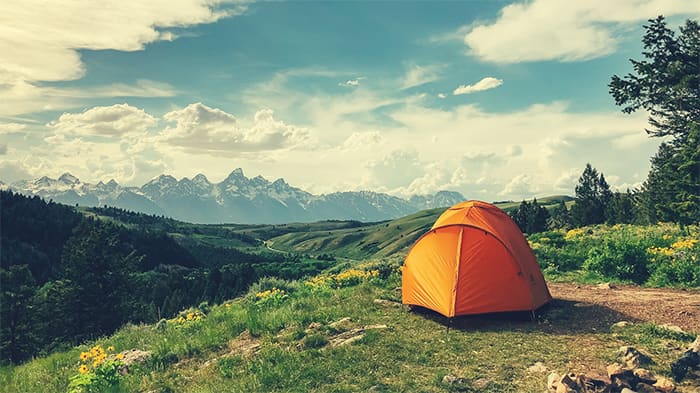The summer heat is finally here, and it can be unbearable. However, the good news is that some tents on the market have AC ports for your convenience. Manufacturers designed these tents specifically to accommodate an air conditioner so you can stay cool in the hot weather.
The design of a tent with an AC port allows for adequate ventilation to keep you feeling comfortable even in the dead heat. So, whether you are looking for a tent on your next camping trip or something to use around the house to stay cool, consider bringing one of these AC tents with you.
In this article, we’re going to review the following tents with AC port:
- Wenzel Klondike 8 Person Water Resistant Tent with Convertible Screen Room for Family Camping
- Bushnell Shield Series 6 Person / 9 Person / 12 Person Instant Cabin Tent
- Coleman Elite WeatherMaster 6 Screened Tent
- Ozark Trail 16×16-Feet 12-Person 3 Room Instant Cabin Tent with Pre-Attached Poles
- Coleman 8-Person Camping Tent with Built-in Closet
Wondering What is a Tent with an Air Conditioning port?
Well, these are tents that have a built-in air conditioner. You can power the air conditioner with either an electric cord or a battery pack.
A tent with an AC port will have all the same features as any other type of camping equipment, including doors and windows for ventilation, ground cloths to protect from dampness and insects, and storage space for gear.
Tents with AC are great when you want to escape from extreme heat but don’t want to give up on your outdoor adventure. They also work well when camping close to home in mild weather so you can enjoy nature without being uncomfortable.
Why You Might Want to Own One
If you go camping a lot and enjoy it, you know that there are times when the weather doesn’t cooperate – it rains, is too hot, or both! It can get challenging to stay cool and dry without a tent with an AC port in these cases.
There are several reasons that this might be important for you:
- One being that an AC port might not break or stop working if there’s a storm because it functions using a battery instead of a cord. If there is a storm, your tent can still protect you from the rain without interruption.
- Another reason is that larger tents with AC ports usually have more room inside (also more stable). This means they’re usually more comfortable when it’s hot outside.
- If you’re camping with your family, this may matter to you as well! If they’re hot, they might not stay as happy as if the AC works.
- Additionally, larger tents tend to have better insulation. This is important because it will keep the temperature from dropping too low at night – and that’s a problem when camping in colder weather!
What are the Advantages of Using Tents with an AC Port?
- Tents with AC ports allow you to stay cool and comfortable in the heat.
- The tents come with a built-in air conditioner that a generator or solar power can power.
- The company designed these tents for easy setup, use, and storage.
- You will never have to worry about running out of ice or electricity again!
- These tents are perfect for those who want an extra level of comfort when camping outdoors!
What Makes a Good Tent with Air Conditioning Ports?
A good tent with an AC port makes you feel safe. A good tent with an AC port will be durable, comfortable, and easy to clean.
It also needs to have the capability of being used for all seasons (winter, summer, spring). You want a tent that has room for your entire family or group of friends without feeling too cramped.
The best tents are ones that will make sure everyone’s privacy is respected while giving them enough space to enjoy themselves.
Finally, the most important thing about a great tent is handling terrible weather conditions like rainstorms or snowstorms; can it withstand high winds? Is there enough ventilation? How does it handle condensation?
What to Look for When Buying a Tent with Air Conditioning Ports
A tent with an AC port is a must-have for camping, but it’s important to know what to look for to find one that fits your needs. You should consider the following features when shopping for a tent with an AC port.
How is the Material of the Tent?
The tent’s material is an essential factor to consider when purchasing a tent with an AC Port. A suitable material will keep you more relaxed in summer and warmer in winter and prevent leaks.
There are many different materials for tents; some are better than others depending on your needs. You should also check how durable the material is to ensure it will last long enough for its price tag!
The most common material used for tents is polyester, which has excellent water-repellent properties, and you can clean them easily. However, this type of fabric doesn’t breathe at all, so it isn’t great if you want to stay cool during hot seasons or warm during cold seasons like wintertime.
Nylon (polyamide) is another common material used to make tents. It has good water-repellent properties and can also clean it quickly; however, unlike polyester, it ‘breathes’ well-meaning that hot air inside the tent will escape outside during the summer months while cold air escapes out too during winter.
PVC-backed poly canvas is also famous among manufacturers who design tents with AC Ports. It’s extremely tough but also water-resistant so that you can use it all year round.
Its other property is that it breathes too, which means hot air escapes out during summer months while cold air escapes out during winter (perfect for staying warm).
Cotton doesn’t have good water-repellent properties and takes a long time to dry if wet through, but it’s incredibly breathable, meaning you can stay nice and cool in the summer months while not getting too cold during the winter. Because it isn’t water-resistant or durable, cotton tents are mainly recommended for summertime use only.
PVC-backed polyester is similar to nylon – both are excellent materials because they both breathe well-meaning hot air escapes out in the summer, but cold air can escape out too in the winter.
It is r is a little tougher and thicker than nylon, so it’s great for areas with lots of wind or rain. It’s still reasonably breathable, though.
Check How Well is the Ventilation
When looking for a tent with Air Conditioning Port, you should consider ventilation. If the tent doesn’t have proper ventilation, it can lead to stuffy air, which is very uncomfortable and dangerous even with an AC port.
An excellent way to think about this is when you’re in your car during an intense heatwave. If the windows are up and there’s no AC, it feels like someone has put a plastic bag over your head.
That’s because, without any airflow or circulation of fresh air, hot or humid air builds up inside the car. The same thing happens in tents where there’s not enough ventilation but an AC port.
The key to cooling down within a confined space is getting more fresh air circulating through it as quickly as possible. The best way to do this with a tent is by getting a good airflow going, ensuring that any hot or humid air gets replaced as quickly as possible with cool, fresh air from the outside.
Hence, if you want a tent with Air Conditioning Port and the most comfortable inside it (hot and humid weather conditions), make sure to choose one with good ventilation features such as mesh panels, windows/doors, and vents.
How Fat is Your Pocket?
Another factor to be conscious of is the price. When looking for a tent with Air Conditioning ports, you must choose one within your budget range. However, some tents can be more expensive than others due to their better build quality and the AC Port feature.
If you’re looking for an affordable tent with an Air Conditioning port that’s easier to transport and doesn’t cost as much, consider choosing a pop-up tent that is very quick and easy to set up.
On the other hand, if you want a more heavy-duty type of tent with an Air Conditioning port and can cope better with extreme weather conditions such as strong winds or torrential rain, consider purchasing one of those heavy-duty tents made from solid canvas material.
Easy Setup
Finding time to set up your tent can sometimes take up all your spare time before heading off to camp. If you’re camping with your family or friends, you might not have much time to spend setting up your campsite.
So, when looking for a tent with Air Conditioning Port, the quickest and easiest setup is key. The pop-up design of some tents is so quick and easy that they can be set up within minutes by one person without any hassle.
Also, consider whether the tent has an electric pump system which is very useful if more than one person is trying to put it together in a short amount of time since it makes the process much easier and quicker!
UV Protection
Air conditioning tents are a great way to cool down in hot climates. But what you might not know is that the air inside your tent can be as much as 30 degrees hotter than outside.
And if it’s too hot, you won’t sleep well and neither will your family or friends! To make sure everyone stays comfortable, make sure to buy a tent with UV protection. This will prevent harmful UV rays from coming through the fabric and into the tent, keeping things cool on even the hottest days of summer.
Comfort
I take comfort as one of the primary key factors when shopping for a tent with an Ac port. Tents with air conditioning ports are more expensive, but it’s worth it if you’re spending hours in them every day.
Campers can convert some tents to have AC by purchasing a separate unit and installing it inside the tent. The air-conditioned tents are generally comfortable.
Height
The height of a tent with an AC port is an essential consideration. Tents are available in different heights, from low to high. Some tents offer two or three stories. One significant difference between these types of tents is the amount of airflow they can provide during hot weather conditions.
A tall tent has more room for circulation and less chance of getting too hot inside than a short one does. On the other hand, tall tents may be challenging to set up because they need more high stakes and poles.
Nevertheless, some people prefer them because there is more headroom for sitting upright on cots, plus it’s easier to put clothes away on hangers instead of folding them over your arm like you would at home.
Size
Size matters when it comes to camping. The bigger the tent, the more room you have for people and gear. Likewise, a more significant AC port will give you a better chance of staying cool because its size means that your air conditioner will be less likely to overheat.
Weight
Generally speaking, smaller tents with an AC port are going to be lighter than larger ones. This is because they have fewer materials used in their construction – less fabric means less weight, especially when thicker or reinforced.
A nitpick against these lighter tents is that they tend to “breathe” better, which means you lose more heat when the cold wind blows through your tent flap at night.
You can resolve this issue by applying a thin layer of mylar or foil insulation sheets to your tent walls before sleeping if you feel cold quickly – it works like a charm! But most importantly, make sure that the company insulated your sleeping bag, warm, and rated for the temps you’ll face in your camping area.
Tent AC Types
The first thing to consider when looking for an air-conditioned tent is its type of AC system. There are three types of systems:
Portable Units Systems
Portable units are self-contained and have both condenser and blower combined into one unit that fits into a small case.
They are similar to window units as they also sit on top of the tent, but you can use them outside or inside and produce a little colder air than a window unit.
These systems are lightweight, so you can carry them from site to site, which is excellent if you plan on going car camping for a few weekends in the summer before heading out bush crafting for the remainder of the year.
Pros
- The units are portable so that campers can take them anywhere.
- They don’t require a lot of space to operate.
- Air quality is better because the tent protects against dust and pollen in the air.
- They’re energy-efficient – it costs less to cool an area with a tent AC unit than it does for central AC. systems because there’s no ductwork or compressor to run
- You can use them as emergency units or even as primary cooling units during the summer.
Cons
- Units can be noisy, especially when they’re running on high settings.
- There’s a risk of water damage if the tent is in an area with heavy rain or snowfall.
Window Units Systems
You can use Window units inside or outside and work by directly cooling your tent. The window unit itself attaches to the window of your tent with two-sided clips that hook onto the side poles. It then has another hose that runs either under or over your tent into an inflatable blower.
This type of system is excellent for smaller tents such as 1 to 2 person tents or small camping trailers because they can direct cool air right where you need it most while also keeping noise levels down.
They are also relatively inexpensive; we purchased ours for a fordable price and could get 2 hours of use out of it before needing a recharge (9 hours total). We liked that the system was small and lightweight. They don’t take up much space at all when in storage.
Pros
- Window AC units are more affordable than traditional central air conditioning.
- You can install them quickly and easily without any construction work or significant renovation.
- Installation is easy to do. You positioned the unit in an open window hole and slid it into place – no need to drill holes or hire expensive contractors.
- The units come with a remote control that allows you to change settings from your couch!
Cons
- Window AC units are typically only effective in rooms up to 100 square feet.
- They produce significant carbon dioxide levels, primarily when used on maximum settings for more extended periods- this can contribute to the poor air quality inside the home if not monitored carefully.
Freestanding Units
Freestanding units are available in a variety of shapes, sizes, and features. These units have a small cabinet-style unit with the air conditioning built-in. Some of these models also come with an integrated dehumidifier.
Freestanding ACs are famous for their convenience, portability, and flexibility when it comes to installation. They are best suited for larger rooms with good ventilation.
Freestanding AC’s have a power output of 7.5 kW to 21 kW, which is enough to cool most enormous spaces in most country regions.
A defining feature of this type of air conditioner is that you can install it anywhere in your tent, unlike window, split, or ducted AC units requiring proper installation near an external wall opening.
The only requirement is that you have adequate space around it for running the exhaust tube outside through a window or door. Another advantage associated with Freestanding AC’s is that they are mobile and easily movable from one place to another within your tent.
Pros
- Freestanding AC units are portable, lightweight, and easy to set up.
- You can use these units in a variety of places ranging from the backyard to the beach.
- The best part about these AC units is that they don’t require any installation – plug them in and turn them on!
- They also come with remote control for convenience and an LCD screen for accurate temperature reading.
- There’s no need to worry about power outlets or extension cords since these ACs work on their battery pack, which lasts up to 8 hours before needing recharging again!
Cons
- Freestanding ACs are typically more expensive than other types of air conditioners. The additional cost is due to these units’ extra features and functions, including higher energy efficiency rating (EER), auto restart, etc.
- The winner of the three above is the portable unit systems. This is because of their flexibility to use in various places and also, they are environmentally friendly. They also have multiple features that you may like.
Source of Electricity for Tents with Air Conditioning Ports
The best tents with AC ports have a generator, solar panels, or built-in batteries. You can also plug tents that use a power cord into an electrical outlet.
This is the most expensive way to go because it requires you to transport an extension cord and an inverter. You will need to purchase these items separately or rent them from the campground if they are available for rental there.
The other option is using batteries that you can charge by solar panels, hand-crank dynamo, or car alternator (if your vehicle has one). It would help if you replaced the batteries periodically, so this option is not cost-effective in the long run unless you plan on camping only at places where electricity supply is already present.
AC Stand
AC stands are a great addition to a tent if you’re camping in a hot environment. The AC stand will keep a cool breeze blowing from the AC unit so that you’ll stay comfortable without being too hot.
It’s also a good idea to use an AC stand if you have small children who get hot and uncomfortable quickly because it’ll help them stay cooler, which will make for a more enjoyable trip.
AC stands are usually easy to set up with most tents, although the setup will vary from one model to another. Manufacturers made most of them from steel or aluminum tubing, which you can fold down for transport.
How to Add AC to a Tent
There are various ways you can add cooling to your tent. The most popular way is by using an AC unit. Two main types of Ac units are available for tents including window-mounted and portable. Both of these types have their pros and cons.
First, you will need to measure the dimensions of the opening on the front side of the tent to determine which type will work best for your needs.
It is important to make sure there is enough space to accommodate the unit before buying it to get the best results possible. The next step is to choose a location inside or outside of your tent.
You will want this area to be free from obstructions so that it can function properly without any problems. It is also important to make sure the unit does not get too hot.
Make sure you measure the temperature near it before using it to avoid any damage or injury. After you have found a good location for your new AC unit, it’s time to plug it in and start enjoying some cool air inside of your tent!
Another way to add an AC to your tent is by either adding a whole-tent AC system or adding an in-tent AC unit. Here we’ll look at both options in more detail so that you can decide which one suits your needs best.
Whole-Tent AC Systems
A whole-tent AC system is a unit that’s added to your existing tent. It cools the air by removing humidity and moisture from the air before reaching you in your tent. Some whole-tent AC systems use a water tank, so you need to fill them up with water periodically.
Other models have tanks that will last for several days of cooling time, meaning that you can go longer between refills.
Several whole-tent AC units are available to purchase, but one of our favorites is the Coleman Evcon 1iT, which can cool a tent up to about 20ft² or 1.6m².
It has both manual and automatic settings so you can decide how much cooling power you need. If you don’t want to spend money on buying your own whole-tent AC unit, you can also hire them for your trip if this is something that other people in your group will be using as well.
In-Tent AC Units
An in-tent air conditioning unit is much smaller and lighter than a whole-tent system, making it better suited to those who will only use an air conditioner infrequently or for shorter periods.
These models can also come as individual units that each cool one person’s area, meaning they’re far more personalized and efficient than using a whole tent model. But they’ll cost more per unit if you have many people sleeping together.
In general, these types of air conditioners work by pumping cold air into the tent through small vents, which you can usually attach to the inside roof of your tent.
One company that produces quality in-tent devices is KoolerAire, with their range of Wazoo units offering an impressive cooling power for its size at just 20lbs (9kg) and up to 18ft² (1.67m²) of cooling space.
It means it’s capable of cooling you down even if you’re sleeping in a large group. Although these models are smaller than whole-tent AC systems, they aren’t as lightweight because they require some power source, which means they’ll need either batteries or recharging, depending on your model.
Check what type of battery you will require before buying. Campers need to drain these units and clean them occasionally, which means it’s a good idea to purchase one with drainage plugs so you can empty the water.
Safety Precautions when Using Tents with AC Port
Before using one of these tents, there are some safety measures that you must take into consideration:
- Make sure the power cord isn’t too close to water or rocks.
- Check if the ground can support its weight without an obstruction
- Double check the power cord and make sure the power cord material can withstand any environmental factors (like rain or wind).
- Make sure that there isn’t any water pooling near where you plan to place your tent.
- Be careful around exposed wires from the AC-powered fan and make sure no one is going to trip over it.
- Keep pets and children away from the AC unit when not under supervision.
- To avoid becoming a danger, always try to use tents with AC ports in entirely safe areas.
The Best 5 Tents with AC Port
1. Wenzel Klondike 8 Person Water Resistant Tent with Convertible Screen Room for Family Camping
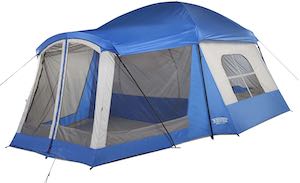
There are tons of great family camping trips out there. But, let’s be honest – who doesn’t worry about the occasional rainstorm?
And with outdoor parties becoming more and more popular, it can get tight inside a typical tent. The Wenzel Klondike 8-person water-resistant tent comes equipped with an inverted “T” style door and zippered windows in the screen room for easy entry and exit when the weather starts to turn sour.
Mesh ventilation will help reduce condensation even if you forget to pack your dehumidifier! With durable seams and shock-corded fiberglass roof frame and steel uprights combined with an easy assembly pin-and ring system; this is one lightweight shelter that’ll keep up with your active family.
Pros
- The Klondike Tent is designed for family camping and can sleep up to 8 people.
- This tent also features a convertible screen room, which makes it perfect for summer camping.
- It has a built-in AC port so you don’t have to worry about the heat while inside the tent on hot days.
- The rain fly is made from 100% waterproof material that will keep you dry in case of inclement weather
- The Klondike comes with two doors and four windows which gives you plenty of ventilation options when cooking or sleeping
- You get all this at an affordable price – making it one of the best tents out there!
Cons
- This tent can be a bit heavy and bulky, especially when carrying it in the car.
- The zipper may get stuck from time to time and break easily – you’ll need to take care of this product.
2. Bushnell Shield Series 6 Person / 9 Person / 12 Person Instant Cabin Tent
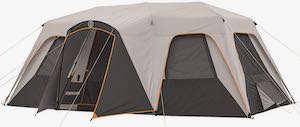
When it’s time to go camping, don’t settle for just any old tent you find lying around. Get the Bushnell Shield Series six-person or nine-person instant cabin tents! They designed these tents with innovative features that will bring you back for them for more every summer.
Built-in wind tunnel stakes prevent gusty winds from pushing your tent down. Instant two-minute setup technology eliminates long waits during set up so you can spend less time-wasting precious daylight and get settled in quickly to enjoy all there is to experience outside.
The heat shield technology ensures cooler temps inside, which are much easier on everyone because no one likes being sweaty when trying to sleep!
With two AC ports/ground vents, each tent comes equipped with electricity so that you can bring along your favorite appliances and gadgets.
The large awning allows for a shaded area or dry storage for extra supplies that need protection from the elements. Each tent features a unique door design, which opens onto an extended covered porch to provide additional shelter from rain and morning dew while waiting to get in the tent.
Inside each tent, enjoy maximum comfort with pockets near each sleeping bag, two skylights above head level, and a gear loft included at no extra cost!
Pros
- The Bushnell Shield Series Instant Cabin Tent is perfect for the family who wants to camp in style.
- This tent has a built-in air conditioner that will keep you cool on hot days.
- You can set this tent up and take it down quickly because of its quick, no-hassle setup system.
- It has plenty of room inside for six people or nine people comfortably and twelve if needed.
- The company made it from aluminum makes it sturdy, durable, and lightweight for easy transport.
Cons
- This tent is rather expensive.
- You cannot transport this tent easily once you have put it unless taking down several poles and carrying them, which can be a hassle for some people.
3. Coleman Elite WeatherMaster 6 Screened Tent
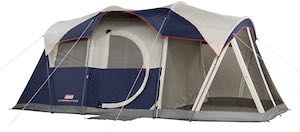
If you’re looking for a family camping tent, the Coleman Elite WeatherMaster 6 Screened Tent has what you need.
The polyester taffeta 75D screen is ideal for six people and two queen airbeds with an attached 9 x 6 ft. screen room that’s perfect for relief from bugs thanks to the mesh windows and doors with zipper protection.
There is also plenty of space inside, even without any extension pieces (sold separately). A LED system offers three brightness settings for overhead interior light; two large windows on each side.
The rainfly comes equipped with ventilation panels, and the WeatherTec system keeps your unit dry and comfortable during rainy days. It will make all your outdoor adventures better than ever before!
Pros
- The manufacturer made these tents from a durable polyester material with a water-resistant coating to help protect them from the elements.
- It has six windows and two doors for ventilation, as well as an AC port so you can stay cool on hot days.
- The screened top helps keep bugs out of the tent while still providing plenty of light through the screens.
- Beautiful, stylish design that comes in four different color options: Green, Blue, and White.
- Instantly transforms from a carrying bag into a full-size tent with no assembly required.
Cons
- It is pretty heavy and may be difficult to transport.
- Some customers have reported that the bottom of the tent has ripped after a few uses.
4. Ozark Trail 16×16-Feet 12-Person 3 Room Instant Cabin Tent with Pre-Attached Poles
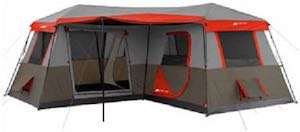
The Ozark Trail 16×16-Feet 12-Person 3 Room Instant Cabin Tent is the perfect tent for group camping! This tent has three queen air beds and even has seven completely closeable windows. It’s great for concerts or family reunions with your whole group of friends or family!
This instant cabin can be set up in under two minutes on any outdoor grounds or a gentle terrain, taking the time of setting up tents down to less than five minutes in total.
The sheer size makes everything easier – like sitting up during mealtime or changing clothes inside out of the rain while still feeling comfortable on solid ground.
We at Ozark Trail love this tent because it is perfect for any family or group of friends that love to enjoy a weekend in the outdoors with plenty of room to spread out and relax.
Pros
- An excellent and large living area with a 16×16 size and height of 8’6″.
- It has an attached porch and screen door, perfect for the entry and exit of air or rain.
- There’s plenty of room to store all your gear onto the porch.
- It has a zippered divider which you can use to create privacy between the other rooms in the tent if needed.
- Awnings offer protection from bugs, dew, and sun.
- The entrance doors offer protection from bugs, dew, and sun.
- It has a durable polyester fabric that is water repellant and UV resistant while still being breathable.
- Durable steel frame.
- Includes stake anchors for securing the tent to the ground and weatherproof rain fly for protection from all kinds of weather conditions.
- They included two storage pockets for better organization.
Cons
- If the stiff poles seem challenging to bend into place, it may take some effort and time before they fit correctly.
- Some users wish the rain fly were longer/broader as it might become inadequate during heavy rains or windy weather.
5. Coleman 8-Person Camping Tent with Built-in Closet
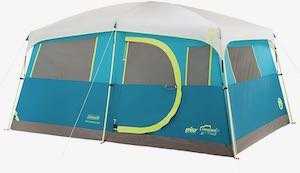
Take your camping game to the next level with this Coleman 8-person tent, complete with a handy closet for storing all your belongings while you enjoy maximum comfort and convenience.
Constructed of durable weather-resistant polyester material, this spacious cabin tent is specially designed for enduring outdoor adventures in colder climates. It provides added space and privacy by including a “room divider” that measures 2 feet wide by 4 feet high.
The Coleman’s patented WeatherTec system delivers reliable protection from rain and dampness as its welded floors, and inverted seams ensure dryness inside the tent even when under harsh conditions outside. Setup takes only nine minutes.
Pros
- The Coleman 8-Person Camping Tent with Built-in Closet offers plenty of space for sleep, storage, and more!
- The company made this tent from polyguard fabric that has a water-resistant coating to keep you dry in any weather.
- It features a built-in closet that provides ample storage space for clothing separate from the sleeping area.
- Includes rainfly for protection against the elements
- It comes with ground stakes and guy ropes for added stability in windy conditions
- There is a roll-up divider that you can adjust to your liking
Cons
- Many people have found the zipper to be challenging to use.
- The tent also has a powerful plastic odor when first taken out of the box.
FAQ
what is a Tent with an AC Port?
A tent with an AC port is a particular type of tent that provides air conditioning for the inside people. You can use these tents in many different situations, such as when people are camping out in the hot sun or during the rainy season.
The air conditioning will help keep you cool and dry while also keeping bugs away. These tents typically come with their power supply so that they don’t need to rely on batteries or generators like other types of portable air conditioners do.
What are the Precautions of Using Tents with an AC Port?
The precautions for using tents with an AC port includes:
Campers should turn off the electricity and unplug when the tent is not in use. This will prevent electric shock from occurring from people who might touch the wires to try and plug something into them.
You should also turn off the air conditioner and unplugged if it’s not used again for a while. This will help save energy and ensure that the AC doesn’t break down from unused for too long.
What is the Source of Electricity for the AC on the Tents?
If the AC comes with its power supply, it should be set up to use a 12-volt battery. This will typically come with an already installed battery which can run the AC for hours without needing any more charging or attention.
If there are no batteries included, the AC unit will need to rely on a generator. These smaller generators will either have gasoline-powered engines or fuel cells that burn natural gas – one of these types is preferable over the other but would depend mostly on where you’re camping because not all areas have access to fuel for them.
Can I Use My AC Port Tent During the Winter?
You can use these tents with an AC port in cold weather, but it’s recommended that they aren’t used when the temperature falls below freezing. This is because there’s no insulation between where people live and where they’re sleeping, which can cause them to get sick if they spend too much time in an area that feels especially cold.
The best type of tent for colder weather is one that comes with its insulation inside – otherwise, just use an extra blanket to help keep yourself warm while you sleep.
Can I Set up My Tent with an AC Port on My Own?
Many of these tents come with complete instructions for setting them up and installing the batteries or generators, so you should be able to do this without help from anyone else.
Some don’t require anything more than putting everything together and plugging it in – others may need more dedication and effort if they’re entirely run by batteries which means you’ll have to ensure that they’re recharged before using them again.
What are the Advantages of a Tent with an AC Port?
Several benefits come along with choosing a tent that has an AC port, including:
- It’s easy to connect the air conditioner to it so you can keep yourself cool while camped out in hot weather or provide warmth if it gets too cold on your camping trip.
- Some will typically come with their batteries, so you don’t need to worry about buying them on your own.
- You can set them up without any pre-setup work required, which makes this easier to do when camping out in the wilderness somewhere far from power lines and building construction that can provide shade against the sun.
- You’ll also be able to control the temperature of your tent using one connected with an AC port. Otherwise, you’d have to rely on several separate air conditioners or heaters, which would make it more challenging to keep the inside of your tent at a comfortable temperature.
- Some come with built-in environmental sensors that estimate how many BTUs they need based on the outside temperature, so you don’t have to worry about overloading the system by setting it too high.
The Verdict
As experienced campers, we have chosen Wenzel Klondike 8 Person Water Resistant Tent with convertible screen room for family camping as the winner among the above five tents. It is because it has a screen room, which can be used as an extra bedroom. This tent also comes in two colors- khaki and dark green.
Furthermore, this Wenzel product is water-resistant, easy to assemble, and includes two doors and four windows for excellent ventilation. The sturdy steel poles make setting up the canopy quick and easy; there are no elastic bands that need to be stretched over metal frames or stakes that will eventually rust out on you as most other tents do.

Fueled by his own lifelong passion for the outdoors, Ryan is dedicated to sharing his knowledge to help others experience the life-changing beauty and majesty of nature. He enjoys planning expeditions throughout the United States. He also has a passion for finding gear and methods that enhance the experience of enjoying nature.
